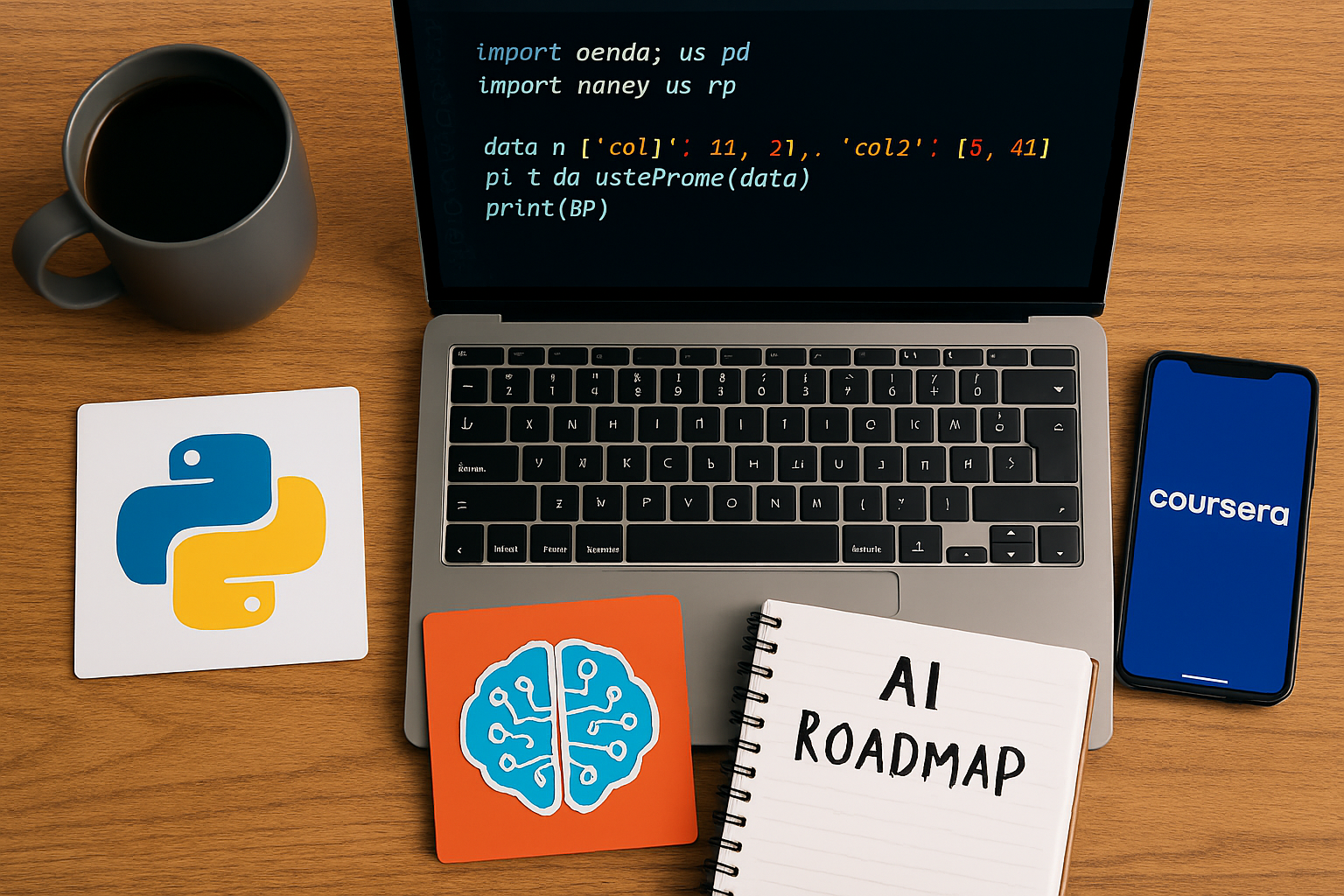
Are you stuck using AI like everyone else, while others are building the next breakthrough? Your peers have moved beyond just prompting ChatGPT. They’re creating their own AI solutions and launching tech startups.
Here’s what most people don’t realize: the real power isn’t in using AI tools, it’s in building them. While others are held back by current tools, you can build custom AI solutions. These solutions can solve specific problems, automate complex tasks, and even help you make money.
AI isn’t the future, it’s right now. And if you’re wondering how to learn AI in 30 days, even without a tech background, this step-by-step guide is for you.
This 30-day guide will take you from complete beginner to building your first AI project, no computer science degree required.
Why AI Matters in Today’s World
The statistics are staggering: over 90% of global businesses plan massive AI investments in the next three years. The demand is exploding. LinkedIn ranks AI and machine learning among the top in-demand skills for 2025.
Opportunities are global. You can work for companies in London, Toronto, or Dubai while living in Accra, Nairobi, or Lagos.
Barriers are low. You don’t need an expensive degree. With structured learning, you can gain competence quickly.
But here’s what makes this moment historic for Africa: we’re not playing catch-up anymore. We’re positioned to leapfrog directly into AI leadership.
Consider this: Mobile money revolutionized African finance before the rest of the world caught up. Solar energy solutions are powering rural communities faster than traditional grids. Agritech innovations are helping smallholder farmers significantly increase their yields.
The job market is already shifting. Companies need AI-literate professionals who understand both technology and African contexts. This isn’t just about getting a job; it’s about creating industries.
Your AI Foundation: Key Concepts Made Simple
Let’s keep things simple. There are a few terms you’ll see often when learning AI, so it helps to get familiar with them early on.
Algorithms are a set of step-by-step instructions used to solve problems. Datasets are collections of information that help teach AI models.
Neural networks are systems inspired by the structure of the human brain.
Datasets are information that teach AI (like thousands of photos to recognize faces)
Training is the process of feeding data into an AI model to improve its accuracy over time. making AI smarter through practice
It’s also important to know that AI isn’t all-powerful. It learns from data, but it doesn’t “think” or truly understand context the way humans do. Recognizing these limits will help you approach AI with the right mindset.
Here’s a fast, focused 30-day plan to learn AI and go from beginner to building your first AI project.
Setting Up Your AI Learning Environment
Essential Tools for Learning AI in 30 Days
Start with Google Colab, it’s free, runs in your browser, and requires zero installation. No fancy laptop? No problem. As long as you have internet, you’re ready to code.
Your AI toolkit:
- Google Colab or Jupyter Notebook (free, browser-based)
- Python libraries: scikit-learn, TensorFlow, PyTorch (all free)
- GitHub account for showcasing your projects
- Kaggle account for datasets and competitions
Learning Resources and Courses
Start with beginner-friendly courses on Coursera, edX, or Udacity. Look for titles like “AI for Everyone” or “Intro to Machine Learning.”
Boost your learning with YouTube tutorials, blogs, and books on AI basics. Many resources are free or low-cost, making learning accessible.
Building Your First AI Workspace
Set up a folder structure on your computer or cloud. Keep datasets, code, and notes organized.
Create your first notebook with Google Colab. Practice importing libraries, loading data, and running simple programs to get comfortable.
Core Concepts and Skills to Master in 30 Days

Week 1: Foundations of Programming and Math
Your mission for week 1 is to understand what AI is, how it works, and set up your toolkit for building. Think of this week as laying the foundation for your AI journey. You’ll get familiar with core concepts and start working with tools that will become your everyday companions.
Here’s the plan;
Days 1–2: Learn the basics; what AI is, its history, and where it’s used today.
Days 3–4: Explore AI categories: machine learning, deep learning, and reinforcement learning.
Days 5–7: Set up your workspace. Begin with Python, Jupyter Notebook, and beginner-friendly libraries like Pandas, NumPy, and Scikit-learn.
Hands-On Projects:
- Write your first “Hello AI” script in Python. This is just to see AI respond to your commands.
- Create your own mini dataset using everyday objects (like listing their colors, sizes, or types).
- Train your first simple machine learning model. You can predict something basic, like tomorrow’s temperature or a test score.
Week 1 Challenge:
Explain AI to a 10-year-old using real-life examples. If you can break it down simply, you’ve understood it well.
Week 2: Intro to Machine Learning

Your Week 2 mission is to teach machines to learn from data and make predictions.
This week is about moving from theory to models that can think (in a limited but powerful way). You’ll learn to train algorithms to see patterns and make decisions.
Here’s the plan;
Days 8–9: Learn the Machine Learning workflow; data collection, cleaning, training, testing.
Days 10–11: Understand algorithms; linear regression, decision trees, and k-nearest neighbors.
Days 12–14: Work with real-world datasets and measure your model’s performance.
Hands-On Projects:
- Predict sales based on past data.
- Classify SMS messages as spam or not spam.
- Analyze trends in sports, finance, or agriculture datasets.
Week 2 Challenge:
Create a model that predicts something helpful in your daily life. For example, it could tell you if it will rain tomorrow or the best time to post on social media.
Week 3: Deep Learning and Neural Networks
Your Week 3 mission is to build AI that can recognize images, understand language, and make smart decisions.
This week, you shift from learning to building, and neural networks are your launchpad. They power much of today’s AI by spotting patterns in data, from images to text. You’ll learn how they work and start creating models that solve real problems.
Here’s the plan;
Days 15–17: Learn the core concepts: layers, neurons, activation functions, and how data flows through a network.
Days 18–19: Work on image recognition with TensorFlow or PyTorch. Start small, like identifying African crops or popular street foods.
Days 20–21: Explore Natural Language Processing (NLP). Build a tool that can read text, detect sentiment, or translate between languages.
Hands-On Projects:
- Train an image classifier for crops, plants, or everyday objects.
- Create a sentiment analysis tool for social media posts.
- Adapt pre-trained models from Hugging Face for your ideas.
Week 3 Challenge:
Build an AI solution for a real-world African need. Something for crop disease detection from phone photos, translation tools for local languages, or fraud detection for mobile payments.
Week 4: Real-World AI Projects and Applications

This week is about two things: building responsibly and finishing strong.
This is where everything comes together. You’ll pick a problem, apply your skills, and present your AI solution like a pro, while making sure it’s ethical and fair.
Hands-On Projects:
Days 22–23: Learn core AI ethics: bias, transparency, and data privacy. Then brainstorm problems AI can solve in your community or field of interest.
Days 24–25: Choose one idea and plan your project. Define inputs, outputs, success measures, and ethical safeguards.
Days 26–28: Build your project, test for fairness, and document your process.
Days 29–30: Improve performance, finalize documentation, and prepare a short demo or write-up.
Hands-On Projects:
- An AI tool detects road traffic congestion from images. It makes sure not to store any personal data, like faces or license plates.
- Chatbot answering FAQs for a local business, with clear disclosure that users are talking to AI.
- Price prediction model for local markets that avoids reinforcing unfair pricing patterns.
Week 4 Challenge:
Present your project to friends, colleagues, or online communities. Get feedback, improve it, and share your work publicly. Your portfolio starts here.
Complete a beginner-friendly AI certification (Google AI, DeepLearning.AI, or Microsoft Learn). It’s proof of your skills and a strong addition to your resume or LinkedIn profile.
Use popular tools:
- OpenAI API: The same technology behind ChatGPT, now in your projects.
- Hugging Face Transformers. This is the GitHub equivalent for AI models. Thousands of pre-trained models are waiting for you to use.
- LangChain – DataCamp. This helps you chain different AI tools together to build more complex applications.
Start experimenting with deploying your models online or building simple apps. Keep learning advanced topics for the next steps.
Practical Tips for Accelerated Learning
Be consistent. Practice every day; short sessions work better than long, irregular ones.
Join online communities like Kaggle, GitHub, or Reddit. Collaborating makes learning faster and more fun.
Utilize free datasets to run your experiments. Also, set small weekly goals to track progress.
Always ask for feedback, whether from online forums or mentors. It helps your skills grow faster.
What Can You Expect After 30 Days?
By the end of this 30-day AI learning challenge, you’ll have a solid foundation in practical AI skills. You’ll get comfortable with essential tools like ChatGPT, Python, and Hugging Face. You’ll learn how to clean datasets and run basic machine learning models.
As you go, you will create a simple project. This could be a chatbot, an image classifier, or a news summarizer. This project will show what you have learned in action. Most importantly, you’ll walk away with a clear sense of your next steps and which AI paths you might want to explore further. You won’t be an expert just yet, but you’ll be far ahead of where you started.
3 Beginner Mistakes to Avoid When Learning AI in 30 Days
Skipping the Fundamentals: “I’ll just jump to the cool stuff.” Wrong. Without Python basics and basic math, you’ll be building on quicksand.
Tutorial Hell: Watching endless courses without building anything. After each lesson, code something, even if it’s broken.
Perfectionism Paralysis: Your first AI project won’t be perfect. That’s the point. Build, learn, improve, repeat.
Overcoming Common Challenges
Yes, the learning curve can feel steep at times. Break big topics into smaller, manageable pieces.
Working with noisy data or incomplete datasets can be frustrating. Practice cleaning and preprocessing data early.
Stay motivated by celebrating small wins, like training your first model or completing a project.
Facing errors or bugs? Use online forums or tutorials to troubleshoot. Continuous learning is key
After 30 Days: What’s Next?

So, how do you keep the momentum going after these 30 days? Start by joining AI communities on platforms like LinkedIn, Reddit, or Discord spaces where you can ask questions, stay updated, and connect with others learning just like you. Make it a habit to read from trusted sources like Towards Data Science or KDnuggets. You can also subscribe to newsletters from DataCamp or the Google AI Blog to stay in the loop.
Keep building. Try new projects and share them on GitHub to grow your portfolio and get feedback. For income ideas, revisit the Top 7 Skills African Freelancers Can Turn Into Digital Products; you might find your next project or side hustle there.
Remember, learning doesn’t stop at 30 days. AI is a vast field full of opportunities. With the skills you’ve gained, doors to careers in tech, automation, and data science are now wide open. Don’t just learn AI, use it to solve real problems that matter to you.
Conclusion
Learning AI in 30 days may seem daunting, but it’s doable, especially when broken down into small wins over 30 days. Start with Python and layer in simple math. Play with data. Build something useful. Stay curious.
You’ve got this. Before the day ends, open that Python course, set a 30-minute timer, and write your first lines of code. By this time next month, you’ll be introducing yourself as an AI builder.
Learning is faster when you’re not alone. If this guide on learning AI in 30 days helped you, share your progress or questions. You can do this on LinkedIn or in online communities.
